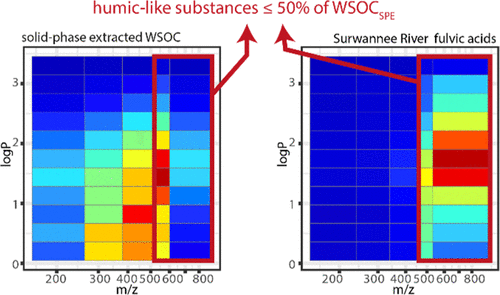当前位置:
X-MOL 学术
›
ACS Earth Space Chem.
›
论文详情
Our official English website, www.x-mol.net, welcomes your
feedback! (Note: you will need to create a separate account there.)
Atmospheric “HULIS” in Different Environments: Polarities, Molecular Sizes, and Sources Suggest More Than 50% Are Not “Humic-like”
ACS Earth and Space Chemistry ( IF 2.9 ) Pub Date : 2020-01-24 , DOI: 10.1021/acsearthspacechem.9b00299 Tobias Spranger 1 , Dominik van Pinxteren 1 , Hartmut Herrmann 1
ACS Earth and Space Chemistry ( IF 2.9 ) Pub Date : 2020-01-24 , DOI: 10.1021/acsearthspacechem.9b00299 Tobias Spranger 1 , Dominik van Pinxteren 1 , Hartmut Herrmann 1
Affiliation

|
To study the complex compound mixture in atmospheric aerosol particles often referred to as “humic-like substances” (HULIS), a recently developed 2D fractionation method combining size-exclusion chromatography and reversed-phase liquid chromatography was applied to a set of 55 aerosol particle samples from five different sampling locations. The resulting heat maps, showing the 2D molecular weight versus polarity space, revealed a distinct seasonal and regional variability in the composition of solid-phase extracted water-soluble organic carbon (WSOC). Different sources were assigned to specific areas of the heat maps based on correlations with atmospheric markers. Biomass burning and secondary organic aerosol formation were found to be the most important sources, both assigned to the largest areas of the heat maps with up to 77 and 69% contribution to the total solid-phase extracted WSOC mass of individual sample clusters, respectively. Coal combustion (14–24%), traffic and industry (4–9%), and soil-derived fulvic acids (5–10%), all assigned to smaller areas of the heat maps, were identified as additional sources. Comparison with the 2D heat map of Suwannee River fulvic acids (SRFAs), a commonly used HULIS surrogate, revealed that only 37–55% of the solid-phase-extracted WSOC occupied similar areas in the molecular weight versus polarity space as SRFA. It is, therefore, suggested that only this fraction might qualify as real atmospheric “HULIS”, while for the broad compound mixture obtained after solid-phase extraction (SPE), denominations like SPE-WSOC or WSOCSPE seem more appropriate.
中文翻译:

不同环境中的大气“ HULIS”:极性,分子大小和来源表明超过50%的不是“类腐殖质”
为了研究通常被称为“腐殖质”(HULIS)的大气气溶胶颗粒中的复杂化合物混合物,最近对大小为55的气溶胶颗粒应用了二维排阻分离法来自五个不同采样位置的样本。所得的热图显示了2D分子量与极性空间的关系,揭示了固相萃取的水溶性有机碳(WSOC)的组成具有明显的季节性和区域差异。基于与大气标记的相关性,将不同来源分配给热图的特定区域。发现生物质燃烧和二次有机气溶胶形成是最重要的来源,两者均分配给了热图的最大区域,分别对单个样本簇的总固相提取WSOC质量贡献了77%和69%。煤燃烧(14–24%),交通和工业(4–9%)以及土壤来源的富里酸(5–10%),都被分配到热图的较小区域,被确定为其他来源。与普遍使用的HULIS替代物Suwannee River富叶酸(SRFA)的二维热图进行比较,发现固相萃取WSOC中只有37–55%的分子量相对于极性空间具有与SRFA相似的面积。因此,建议仅该馏分可作为真实的大气“ HULIS”,而对于固相萃取(SPE)后获得的广泛化合物混合物,则使用诸如SPE-WSOC或WSOC之类的名称 交通和工业(4–9%),以及源自土壤的黄腐酸(5–10%),都分配给了热图的较小区域,被确定为其他来源。与普遍使用的HULIS替代物Suwannee River富叶酸(SRFA)的二维热图进行比较,发现固相萃取WSOC中只有37–55%的分子量相对于极性空间具有与SRFA相似的面积。因此,建议仅该馏分可作为真实的大气“ HULIS”,而对于固相萃取(SPE)后获得的广泛化合物混合物,则使用诸如SPE-WSOC或WSOC之类的名称 交通和工业(4–9%),以及源自土壤的黄腐酸(5–10%),都分配给了热图的较小区域,被确定为其他来源。与普遍使用的HULIS替代物Suwannee River富叶酸(SRFA)的二维热图进行比较,发现固相萃取WSOC中只有37–55%的分子量相对于极性空间具有与SRFA相似的面积。因此,建议仅该馏分可作为真实的大气“ HULIS”,而对于固相萃取(SPE)后获得的广泛化合物混合物,则使用诸如SPE-WSOC或WSOC之类的名称 结果表明,在固相萃取的WSOC中,只有37–55%的分子量相对于极性空间具有与SRFA相似的面积。因此,建议仅该馏分可作为真实的大气“ HULIS”,而对于固相萃取(SPE)后获得的广泛化合物混合物,则使用诸如SPE-WSOC或WSOC之类的名称 结果表明,在固相萃取的WSOC中,只有37–55%的分子量相对于极性空间具有与SRFA相似的面积。因此,建议仅该馏分可作为真实的大气“ HULIS”,而对于固相萃取(SPE)后获得的广泛化合物混合物,则使用诸如SPE-WSOC或WSOC之类的名称SPE似乎更合适。
更新日期:2020-01-26
中文翻译:

不同环境中的大气“ HULIS”:极性,分子大小和来源表明超过50%的不是“类腐殖质”
为了研究通常被称为“腐殖质”(HULIS)的大气气溶胶颗粒中的复杂化合物混合物,最近对大小为55的气溶胶颗粒应用了二维排阻分离法来自五个不同采样位置的样本。所得的热图显示了2D分子量与极性空间的关系,揭示了固相萃取的水溶性有机碳(WSOC)的组成具有明显的季节性和区域差异。基于与大气标记的相关性,将不同来源分配给热图的特定区域。发现生物质燃烧和二次有机气溶胶形成是最重要的来源,两者均分配给了热图的最大区域,分别对单个样本簇的总固相提取WSOC质量贡献了77%和69%。煤燃烧(14–24%),交通和工业(4–9%)以及土壤来源的富里酸(5–10%),都被分配到热图的较小区域,被确定为其他来源。与普遍使用的HULIS替代物Suwannee River富叶酸(SRFA)的二维热图进行比较,发现固相萃取WSOC中只有37–55%的分子量相对于极性空间具有与SRFA相似的面积。因此,建议仅该馏分可作为真实的大气“ HULIS”,而对于固相萃取(SPE)后获得的广泛化合物混合物,则使用诸如SPE-WSOC或WSOC之类的名称 交通和工业(4–9%),以及源自土壤的黄腐酸(5–10%),都分配给了热图的较小区域,被确定为其他来源。与普遍使用的HULIS替代物Suwannee River富叶酸(SRFA)的二维热图进行比较,发现固相萃取WSOC中只有37–55%的分子量相对于极性空间具有与SRFA相似的面积。因此,建议仅该馏分可作为真实的大气“ HULIS”,而对于固相萃取(SPE)后获得的广泛化合物混合物,则使用诸如SPE-WSOC或WSOC之类的名称 交通和工业(4–9%),以及源自土壤的黄腐酸(5–10%),都分配给了热图的较小区域,被确定为其他来源。与普遍使用的HULIS替代物Suwannee River富叶酸(SRFA)的二维热图进行比较,发现固相萃取WSOC中只有37–55%的分子量相对于极性空间具有与SRFA相似的面积。因此,建议仅该馏分可作为真实的大气“ HULIS”,而对于固相萃取(SPE)后获得的广泛化合物混合物,则使用诸如SPE-WSOC或WSOC之类的名称 结果表明,在固相萃取的WSOC中,只有37–55%的分子量相对于极性空间具有与SRFA相似的面积。因此,建议仅该馏分可作为真实的大气“ HULIS”,而对于固相萃取(SPE)后获得的广泛化合物混合物,则使用诸如SPE-WSOC或WSOC之类的名称 结果表明,在固相萃取的WSOC中,只有37–55%的分子量相对于极性空间具有与SRFA相似的面积。因此,建议仅该馏分可作为真实的大气“ HULIS”,而对于固相萃取(SPE)后获得的广泛化合物混合物,则使用诸如SPE-WSOC或WSOC之类的名称SPE似乎更合适。











































 京公网安备 11010802027423号
京公网安备 11010802027423号